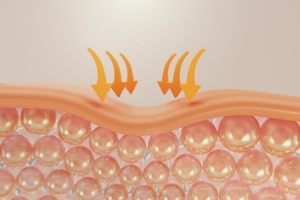collagen through a series of enzymatic processes. The collagen production process requires adequate amounts of iron and vitamin C. Each type of collagen is composed of 3 helices Fibroblast cells are responsible for producing
What is the process of collagen degradation called – glycation
It is an extracellular, non-enzymatic process that occurs in the extracellular matrix (ECM). The process generates a biological reaction related to sugar molecules (glucose, fructose), which generates AGEs (Advanced Glycation End Products)
These molecules are associated with the aging process; the ability of collagen networks to link deteriorates, as does their ability to regenerate (remodelling). These molecules are associated with diseases such as diabetes, Alzheimer’s, and kidney failure. Additionally, prolonged exposure to UVA rays also affects the production and function of AGEs molecules. Several studies have shown that one of the AGEs molecules accumulates on elastin tissue and creates internal changes in this tissue
- What types of collagen are found in the dermis layer
Type 1 collagen: It constitutes 85%-80% of the dermal matrix and is responsible for the strength of the dermis. This collagen is significant in aging processes - Type 3 collagen: Also known as reticular collagen, it constitutes 15%-10% of the dermal collagen. Its structure is smaller, allowing for more flexibility in the skin, and is found in highconcentrations around blood vessels
- Type 4 collagen: Found in the basement membrane
- Type 5 collagen: Distributed diffusely in the dermis and comprises about 5%-4% of the matrixType 7 collagen: Component of the fibres found in the dermoepidermal junction (Dej) and
- stabilizes it. Highly influenced by UV rays
- Type 17 collagen: Located in the Hemidesmosome


